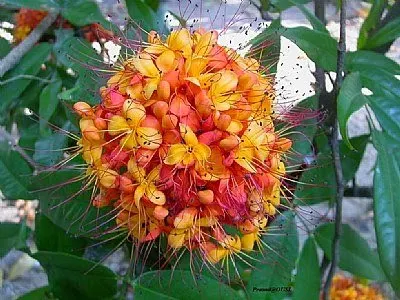By Liliana Usvat
Blog 310-365
Ashoka allowed to grow naturally into a normal large tree with plenty of shade.
Medicinal Uses

Blog 310-365
Ashoka is one of the most legendary and sacred trees of India, and one of the most fascinating flowers in the Indian range of flower essences. It belongs to Caesalpaeniaceae family.
Known to Indians since vedic period, Ashoka tree is one of the most beautiful plants of the Indian forests. In Atharva veda parishishta it is mentioned that color of flowers of Ashoka is red. Known botanically as Saraca indica or asoca ,uniqueness of Ashoka tree lies in being known as woman’s friendly tree.
Ashoka tree is also known by the name of Hempushpa, vanjula,Tamra pallava (leaves are copper like when they start emerging) ,Kankeli, Gandhpushpa (Flowers having fragrant smell), kankeli and pindpuspa.
A small ever green tree having bark with warty surface, Ashoka tree has its flowering season in March April. Ashoka tree has fragrant orange or orange yellow colored flowers arranged in dense corymbs. Though available in central and eastern Himalaya, its concentration is reported in South India. It is believed that Ravana had a separate garden of Ashoka tree.
It is a very handsome, small, erect evergreen tree, with deep green foliage and very fragrant, bright orange-yellow flowers, which later turn red. The flowering season is around April and May. It is found in central and eastern Himalayas as well as on the west coast of Bombay.
Ashoka is a Sanskrit word meaning without grief or that which gives no grief. Of course, the tree has many other names in local languages as well. One such name means the tree of love blossoms. The Hindus regard it as sacred, being dedicated to Kama Deva, God of Love. T
he tree is a symbol of love. Its beautiful, delicately perfumed flowers are used in temple decoration. There are also festivals associated with this flower. Lord Buddha was born under the Ashoka tree, so it is planted in Buddhist monasteries.
Medicinal Uses

- Herbally, the bark of this tree is a household remedy for uterine disorders. The essence also helps women to be fertile. It is said that 'weeping woman, weeping womb,' in that the woman's emotional state affects her reproductive organs. Therefore, the essence, like the herb, helps in the uterine problems like excessive bleeding, irregular menstrual periods and infertility.
- An extract of the Ashoka flower can be used to effectively treat hemorrhagic dysentery. The extract is made by grinding the flowers along with some water. Doses of 15–60 drops can be taken.
- For internal piles, the bark of the Ashoka tree can be used. To prepare the decoction, take around 90 grams of the bark and boil it in 360 ml of water and 30 ml of milk until the entire quantity reduces to around 90 grams. Two to three doses of this can be taken each day.
- The specific analgesic properties present in Ashoka can used to calm the nerves when they have been aggravated by the Vata.
- The Ashoka herb is also said to improve the complexion of skin. This herb can be used to obtain relief from burning sensations on the skin. It also helps to get rid of the toxins from the body. The Ashoka herb is also effective in purifying the blood naturally and in preventing skin allergies.
- The other Ashoka tree uses include treating the sting from a scorpion. The bark of the tree is used for scorpion sting treatment.
- Dried Ashoka flowers can be helpful in treating diabetes
- Seed powder of Ashoka with water helps to check kidney stone.
- Decoction of bark of Ashoka tree is useful in amenorrhoea, leucorrhoea and other gynaecological disorders. Use of Ashoka bark tones the musckes of uterus.
- When there is pain due to scanty menstruation, use of Ashoka’s bark gives good result.
- Overdose of Ashoka bark acts as abortifacient. I.e it aborts the foetus. In market it is adulterated with barks of some other plants like polyialathia longifoila which do not have such side effects. That is why its ill effects of overdose are not reported
- Milk boiled with decoction of bark of Ashoka tree is useful in excessive bleeding in female
















